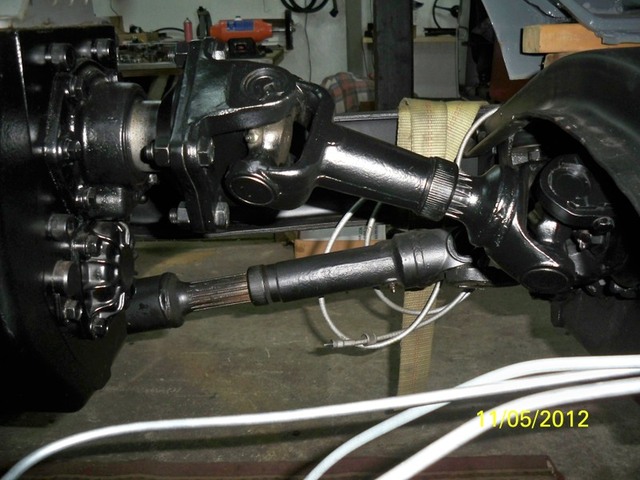
Posted by dave horvath [24.131.120.209] on Monday, February 04, 2013 at 18:18:55 :

You can learn from my mistake.
I was experiencing noticeable clunking of the intermediate driveshaft at low rpms in the 1967 WM300 with 318 and NP435. The noise settled to a strong vibration at high rpms. The driveline angles originally checked out OK, but when we removed the intermediate shaft, we could move the entire transfer case by hand well over 10 degrees. The bolts that hold the transfer case in the mounting brackets had worked loose. Starting from a dead stop, the torque was rocking the transfer case in the mounts, loosening the bolts. Yes - I had tightened the bolts securely and used safety wire, but I did not install the wire properly to hold the bolts in check against each other.
John S. sent me a pdf with a picture showing proper installation of the safety wire. I couldn't post the entire pdf, but here is the text:
"Using standard (0.032 inch diameter) stainless steel safety wire, begin by sliding the wire through two of the
holes that are 180° apart (see upper diagram). The twists should be six per inch minimum, with a maximum of 12 twists per inch. Also, only safety wire bolts in pairs as shown in the bottom diagram. Do not string along.
•Note: Safety wire (also known as lock wire) is used to prevent a fastening device from coming loose. It is not a substitute for a secure fastener.
•Safety wire must always tend to tighten the bolt. For a bolt or screw that is tightened by turning it in a clockwise
direction, the installed safety wire must tend to pull in a clockwise direction. Select the bolt head holes that would best produce this tightening effect.
•Safety wire must be tight when installed.
•Safety wire must be the proper size.
•Safety wire must never be over stressed. Care must be taken when twisting safety wire together or pulling it tight, not to tighten it so much that it will break under even a light load. Making sharp bends
or kinks in the wire must be avoided because they produce stress points in the wire and could cause it to break.
•Always use safety wire pliers to twist the safety wire.
•Safety wire ends must be secured. When installation is complete, the remaining ends are twisted together to form a pigtail (see upper diagram). It is standard procedure to wrap the pigtail around the part being safety wired and tucked down out of the way.
•Torque values must never be changed to obtain an ideal safety wire position!
•Never reuse safety wire. If you make a mistake, throw that piece away and try again. Safety wire is cheap."
Can't wait for John to come down with the safety wire pliers to get the bolts wired right.
We will be relieving the tapered ends of the intermediate shaft so it can flex (shorten) more, but that's another story.
Follow Ups: